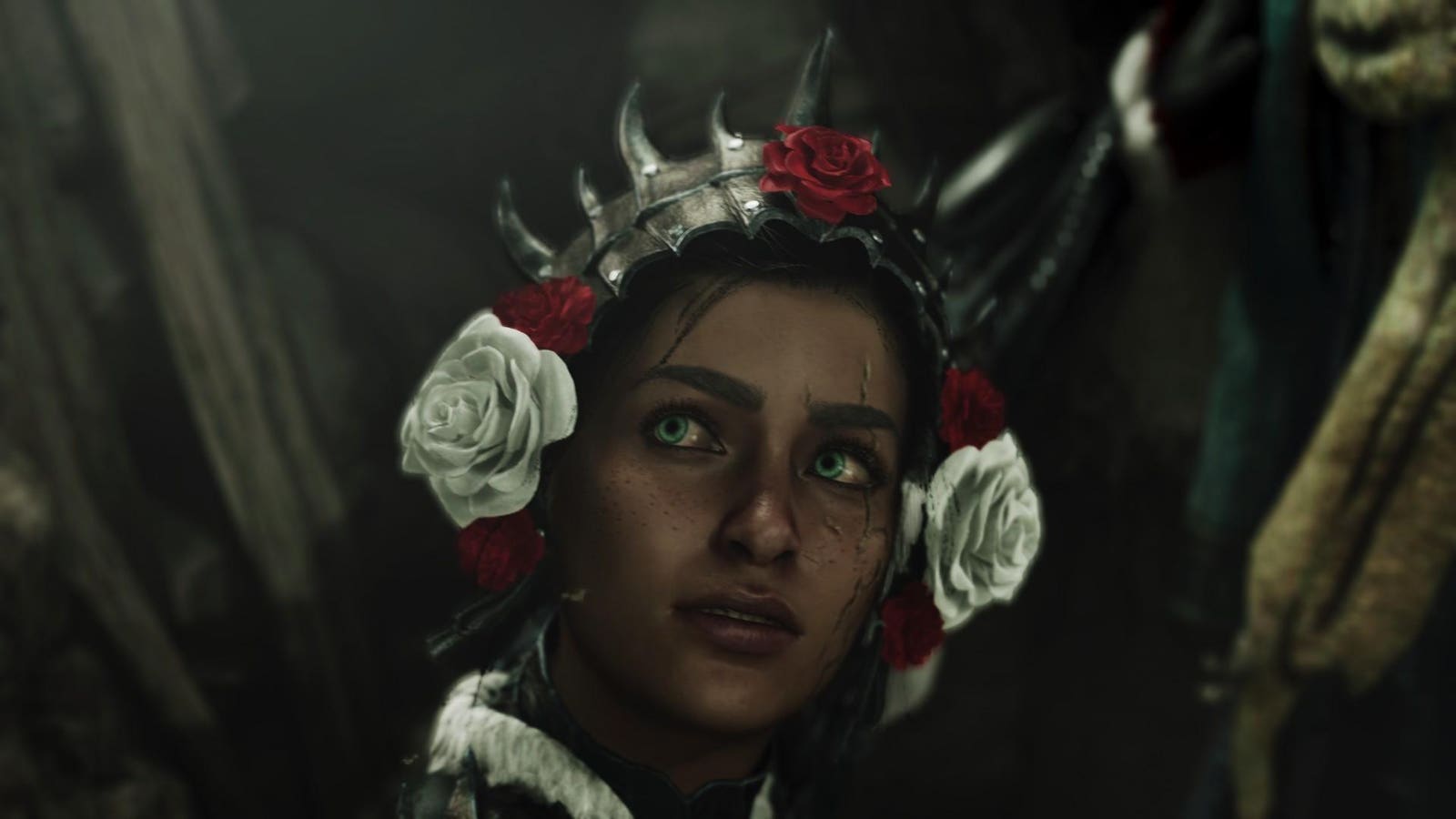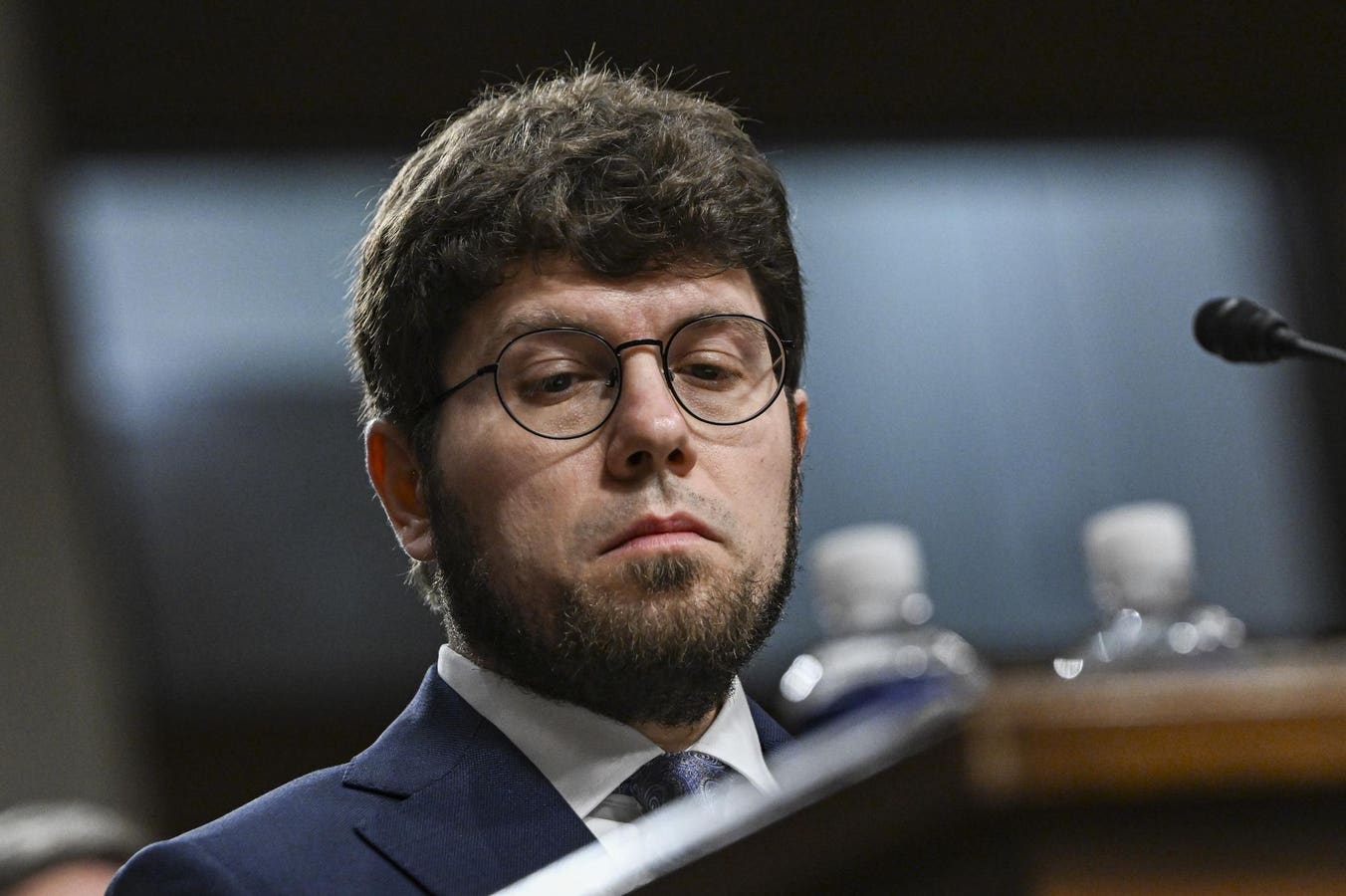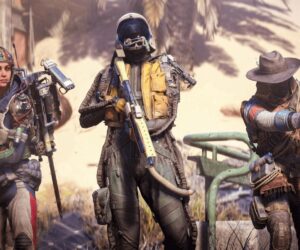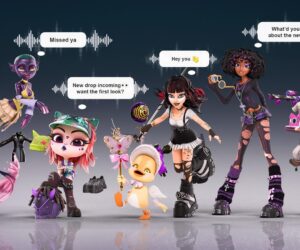The multi-talented musician, voice actor, and singer, Takenobu Mitsuyoshi.
©SEGA
One of the more colorful and fun people in gaming is Takenobu Mitsuyoshi, who has made a career of composing great game music and memorable voiceovers.
Considering the depth and breadth of Mitsuyoshi’s work, I wanted to find out more about where he came from and what he enjoyed doing when he was growing up.
“I was born on December 25, 1967, in Fukuoka Prefecture, which is located in the south of Japan and is famous for its tonkotsu ramen. Because my father was a salesman, our family moved house several times, first to Chiba Prefecture when I was 3, then to Sendai City in Miyagi Prefecture when I was in my second year of high school. Later and finally, I joined what was then Sega Enterprises and moved to Otorii in Ota Ward, Tokyo.
“As for my early exposure to music, my mother was a huge music lover. She played The Platters’ Only You to me over and over since I was a small child, and I actually still have a faint memory of that. A little later, when I was about four or five, she showered me with Paul Mauriat’s El Bimbo.
“In terms of learning English, when I was in kindergarten, the school happened to be a mission-based one. I’m not Christian, and my birthday has nothing to do with that, but back then, there was an optional English lesson after kindergarten that I somehow ended up attending. There, we repeated words after hand-drawn panels with pictures of fruits like “apple” and “grapes,” which were hand-crafted by the teacher, and sometimes they had game-based lessons. I still remember those lessons were a lot of fun.
“Speaking of mission-based schools, the university I attended, Tohoku Gakuin University, also had a chapel on campus. I used to join the services to listen to the pipe organ. At the end of each service, we sang hymns, and I liked the beautiful harmonies they had. Eventually, I came to desire to play the pipe organ by myself so strongly that I even took a music course that was normally taken by first-year students in my senior year, and I managed to experience playing the organ in the chapel.
“People often say that childhood experiences have a big impact on your later life, and looking back, in my case, I think those English lessons and English songs sparked my interest in the language. Also, I believe that being exposed to the English songs and instrumental music through my mother had a profound influence on the composing in the games I was involved in.
“Aside from that, as a child of my generation, I was fascinated by action and sci‑fi shows and toys such as Kamen Rider, Ultraman, and Microman. That fascination may have eventually evolved into a desire to appear on television, which then shifted into simply wanting to stand out, and perhaps that eventually led me toward becoming a performer and entertainer.
“As for how I got into music, I think I started composing music by myself when I was about 16. At that time, I was completely captivated by the synthesizer sounds of Yellow Magic Orchestra (YMO), the group behind hits like Technopolis and Rydeen, which a friend had introduced to me. Driven by a single desire to play the keyboard along with their music, I asked my parents for a keyboard as a birthday present, and they bought me one.
“At first, I simply played the melodies by ear, but then I discovered there was sheet music for their songs. I bought some at a record store, and through that I learned how to read the sheets and understand chords.
“As I experienced the enjoyment of listening to and playing their music, I came to be restless and feel an indescribable feeling while waiting for their next release. How am I supposed to deal with this frustration of wanting to listen to their new work but not being able to? An answer I came up with was: “If I can’t listen to new YMO music, I’ll just make music like YMO myself.” I know how fearless and bold the thought was, but it was also true that that idea led me to start composing original music.
“In the meantime, YMO paused their activity, and I lost my musical anchor. Around that time, another friend introduced me to another band, Mint Jams, an album with an illustration of jam jars. The music there was instrumental, clearly in the lineage of YMO, yet had a unique jazz-like chord progression and familiar synthesizer tones, sprinkled with intricate passages. I was amazed to learn that this music was performed entirely by hand, by a four-member fusion band called Casiopea, which made me feel that the era of live, hand-played performance was coming.
“Later, when I moved to Sendai, I happened to meet a piano teacher who ran one’s own private school. I studied classical piano there with her for six years, until I graduated from university, but my sole motivation for learning was just to see how fast I could move my fingers. At the same time, I was involved in my university’s pop music club, where we covered fusion bands like Casiopea and T-Square, so I became quite absorbed in music.”
It was here I wanted to know how Mitsuyoshi had ended up moving into video games, as that’s quite a specific career progression from where he started out.
‘Daytona USA’ has one of the best opening songs in all of videogames.
©SEGA
“I believe the very first game I played was Epoch’s TV baseball game. Back then in Japan, professional baseball was popular, and it was the era of the Yomiuri Giants. I was so passionate about baseball that I joined a local youth team and even dreamed of one day becoming the Giants’ clean‑up hitter. So when I heard there was a way to play baseball on a television screen, I begged my parents to buy me the game. That TV Baseball was probably my very first encounter with video games.
“Later, the Famicom was born, but instead of going for it, I bought what was then called a “personal computer” for home use and became hooked on PC games. When I entered university, I played PC Engine and Famicom games just like other teenagers, but in my senior year, I got so absorbed in SanGokuShi: Chuugen no Hasha that I nearly failed to finish my graduation thesis, a memory I can laugh about now.
“As for arcade games, I ended up at my job, except for the time when I timidly visited a game center to play the Space Invaders during its boom, I actually didn’t go there on a regular basis until I decided to pursue my career in the game industry.”
“My major in university was economics, so if I had simply focused on my studies and achieved good grades, the typical career path would have been to become a banker or perhaps a store manager in the family restaurant industry, which was booming at the time. Also, there was another option of becoming a teacher, so I decided to give it a try and took part in a teaching practicum. However, during that time, I came face‑to‑face with reality and realized that I’m not suited for teaching. That was in the summer of my senior year.
“Since then, I began my job search rather late, but I was struggling to find an industry to go into. Then one day, while riding in a car that my junior from the pop music club was driving, a certain piece of music that he suddenly turned on caught my ear.
“It was an instrumental track without vocals, featuring a wide variety of synthesizer‑like tones, and the style was a fusion of jazz and funk. It was very close to the genre of fusion I loved. I immediately asked him, “Who is this by, and what’s the title?” To my surprise, he told me it was performed by a band called S.S.T. Band, made up of members from the sound development department of a video game company, Sega. The music being played was an arranged version of tracks from their games.
“The idea of being a company employee yet able to release CDs, perform in a band, and create music as part of one’s job fascinated me. Furthermore, if you listen to the original game tracks, recorded directly from the arcade boards, you will find that the sampled slap bass, drums, and FM synthesis sounds have a certain freshness. In that moment, I decided: my career would be in the video game industry.
“I began researching companies and sent postcards, since the internet didn’t exist yet, to request materials from Namco, Konami, Taito, and Sega. Eventually, I secured interviews with Konami and Sega, and I chose to join Sega Enterprises’ R&D division, home of the S.S.T. Band, where I began working on game sound development.”
Mitsuyoshi is also known for his vocal work on games, not only singing but also character voice-overs, and this is also a very specific thing to have moved into. Naturally, he was kind enough to explain how that happened.
“I think the turning point was probably when I implemented my own singing in Daytona USA. To be honest, up until then, I had never thought of my voice, my singing, or even the title “vocalist” as something that could stand on its own as a job, or something I should try to make into one. At that time, we were tasked with creating a driving game that would surpass a rival title in every possible way, and it was simply that we saw only one option: to add vocals.
“When I made that choice, it never even crossed my mind to bring in another singer. So once the prototype of Let’s Go Away was implemented, my voice was recorded as data on the game board, and eventually it crossed oceans and reached the ears of players all over the world. I had no idea that would happen. But from that point on, people around me gradually began to see me as “the guy who sings.”
“Around the same time, Virtua Fighter 2 was released, and the company was running all kinds of promotional campaigns. One of those ideas was to create a vocal album inspired by the game. Yu Suzuki, who was the producer of the game back then, said to me, “Why don’t you sing a few songs?”, and that became my very first job as a vocalist.
“Later, while the Virtua Fighter anime aired, I was chosen to sing the opening theme for the second season, Aiga Tarinaize (There’s Not Enough Love), which helped raise my profile as a singer. Then, I received a request to “sing the opening theme” for the Sega Saturn title Burning Rangers, which Naofumi Hataya, my colleague who had joined the company in the same year, was involved in. I had sung on some of his tracks before then, but this was the first time I got an opportunity to sing a song that graced the opening of a game title. That moment really cemented singing as one of my official roles in later life.
“I’ve already talked about the methodology behind creating the music for Daytona USA in various places before, but back then, the methodology of streaming recorded music directly was yet established for sound drivers for arcade games. Instead, the only available method was to use instrument tones, individual samples of built‑in sound sources, and have the sound driver play them back to create the music. Because of that, implementing a full song with lyrics, as in conventional music production, was in practice impossible.
‘Burning Rangers’ was one of the few games on the Saturn that really pushed the hardware to its limits.
©SEGA
“So I came up with the idea of treating the vocal as if it were an instrument. I recorded the singing first, then cut the material into individual words, and assigned each of those to keys on a keyboard. In this way, the vocals could be stored as the built‑in sound source and could be played back as sampled tones within the music.
“Fortunately, starting with Virtua Fighter, the sound driver was completely overhauled. A new program was developed that allowed us to take music composed in a DAW and implement it directly into the game. Daytona USA followed that, and with their improved representation in music, songs with lyrics could be reproduced much more vividly in the game.”
One of the more formative games Mitsuyoshi worked on was Sega Rally Championship, which still has the best game over jingle in all of games. The process for that was also very involved, as Mitsuyoshi explains.
“The sound for Sega Rally Championship also inherited the same sound drivers used in Daytona USA, so we used a similar approach: sampling the vocals, breaking them into segments, and assigning those pieces to different keys to be played back.
“However, in the case of Sega Rally Championship, the hardware had improved, which meant we could sample longer phrases. That’s why the “Game Over Yeah” jingle you heard when the game ended wasn’t split into separate parts. Instead, we sampled the entire phrase as‑is and used it directly in the game.
“Honestly, I never imagined that this jingle would end up leaving such a lasting impression on players all over the world. At last year’s GDC, I happened to have lunch with a game industry professional who’s also a big Sega fan. He told me, “When I hear the ‘Game Over Yeah’ jingle after I fail to finish a course, the song somehow lessens the frustration for not being able to finish. It was more like an encouraging ‘Yeah!’, as if it’s saying, ‘Don’t worry about it, cheer up!’ It actually made me want to keep playing.”
“Now, after hearing such a thoughtful and heartwarming interpretation of that, I almost feel bad admitting this, but the truth is: I actually didn’t have a clear reason for adding that ‘Yeah’. As far as I remember, it was simply because it sounded good and fit the atmosphere of the jingle’s melody line.
“That said, ever since Virtua Racing, I’ve had a personal rule: for the ‘Game Over’ jingle or sound, I must sing the words ’Game Over’ as lyrics. So in Daytona USA, you’ll hear me repeating “Game Over” in exactly that way.
Moving on from arcade games, Mitsuyoshi started work on the Shenmue series. The production for that game is widely known to have been drawn out and difficult, but Mitsuyoshi learned how different console games were to score compared to arcade games, as he explains.
“The Shenmue music was definitely a turning point in my career at Sega. I had served as a sound director a few times before then, but this was the first time I was leading the sound team of nearly ten people (including external composers) in a role that was more like a manager, directing the project for the entire team. Because of that, the amount of time I could personally spend on composing music was drastically reduced.
“Back then, we had weekly ‘sound meetings’ in the office of Yu Suzuki, who was the producer. In those meetings, the sound team presented all the music we had created over the previous week to get his approval or feedback, as well as to decide which scenes each track would be assigned to, based on how well the music matched the imagery.
“Through those interactions with Suzuki, I realized there was a huge difference between composing for arcade games and for a console title like Shenmue. To explain, arcade game music is a lot like TV commercials. It’s all about grabbing the audience’s attention as quickly as possible, with maximum impact and catchiness right from the start, so you can pull them into the game’s world in a very short time.
“Console game music, on the other hand, is something the player listens to for a much longer time. It needs to avoid causing ear fatigue, yet still have presence, and ideally be able to evoke a scene or atmosphere on its own, which is much closer to film music. Thus, the approach of composing is almost the complete opposite.
“That said, even in console games, certain tracks like the main theme still need to be catchy and impactful, because they represent the entire story in a single piece of music. When I composed Shenmue’s main theme, I kept that in mind throughout the process.”
Following Shenmue, I wanted to know how he got involved in Virtual On Marz and voicing Sgt. Hatter. This was, at the time, the first console-only Virtual On game, so characterization was more important, something Mitsuyoshi was happy to share.
“For the Virtual On series, the music had always been composed by another member of the sound team, not me. In fact, you could say he was the one who really defined the direction of music for the series. During the development of Marz for PlayStation 2, there came a point where assistance for him was requested. I’m not entirely sure why they turned to me. Maybe it was because I had arranged and sung a vocal version of Conquista Ciela for another project, but I ended up joining the team.
“If I remember correctly, around the same time, the director also requested that I voice a new character in Marz Sgt. Hatter, using my own voice. So I eventually end up contributing both a few tracks and some voice work for the game.
“As you probably know, the Virtual On sound leans heavily toward programmed, synth‑driven tracks with catchy melodies rather than live instrumentation. That style actually fit quite well with my own musical background (something I mentioned earlier), sound creation through synthesizer, which was shaped by the influence from YMO’s works, or my experience in fusion music, where you focus on crafting a strong, melodic lead line without relying on lyrics or vocals. Thanks to that affinity, I was able to step into the project without much resistance and really enjoyed the process.”
More recently, Mitsuyoshi has worked on quite a few non-Sega games, so I wondered how that came about.
“I’m guessing your question is probably about the F-Zero arrangement I worked on for Super Smash Bros. This was a collaboration project based on a request from Nintendo.
I eventually decided to play to my strengths by turning the F-Zero music into a medley-style and creating a vocal cover with English lyrics, but throughout the process, I paid very close attention to the overall sound image, audio quality, and arrangement, constantly thinking about how to make a vocal track work in a way that wouldn’t interfere with the gameplay experience.
“After the release, I happened to receive a lot of praise at many different places, and it really made me realize just how influential that game is. At the same time, this project became one of the most meaningful works in my long career at Sega.”
Finishing up, I wanted to know how Mitsuyoshi felt about his various voice-over work compared to his musical composition for games, and what hopes he had for the future of his work.
“As you may imagine, I think the two have completely different aspects. For me, composing feels like working from the inside, while voice acting feels like projecting outward, and I hope that image makes sense to you.
“To be honest, when it came to voice acting, I never thought that performing alongside professional voice actors would become part of my job, or even one of my strengths. In that sense, it’s similar to how I never initially thought of singing as one of my advantages.
“That said, over time, getting involved in projects as a voice actor, I came to think that voice acting can actually influence my work as a composer. Even just singing is, in a way, about “playing a role” through melody and lyrics. Acting is an essential factor in voice work, and I think there’s been a kind of synergy between that and my singing skills. So, you could say they’re different, and at the same time, not so different.
“More recently, I composed a track at the end of last year. I was involved from the very beginning and took on more of a producer-like role, starting with defining the concept of the song, deciding on the lyrics, setting the direction for the arrangement, and even planning the promotional rollout. In the future, I’m thinking of creating music from that kind of comprehensive, big-picture perspective as one of my future approaches.
“On another note, Sega’s latest entry to the Sonic franchise, Sonic Racing: CrossWorlds, has been well received, and its collaborations with various artists have also become a hot topic. As an employee, I’m not sure whether it could be through composing or singing, but if I were to be involved in some way, I would try to ensure that my contribution not only surprises players but also adds to the fun of the game.
“Lastly, here at Sega Sound Team, we began running the official X (Twitter) and the Sega Sound Team YouTube channel, and one of the programs I appear in is called Sega Sound Street. In the future, I think it can be great if I could create and release a soundtrack featuring Sega songs I’ve performed on the show, as well as original tracks.”
If you are interested in the other interviews I’ve done with creators like this, then you can browse through links to those here.
Follow me on X, Facebook and YouTube. I also manage Mecha Damashii and am currently featured in the Giant Robots exhibition currently touring Japan.









